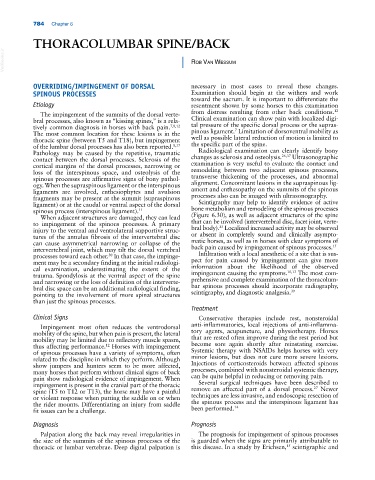Page 818 - Adams and Stashak's Lameness in Horses, 7th Edition
P. 818
784 Chapter 6
THORACOLUMBAR SPINE/BACK
VetBooks.ir Rob Van Wessum
OVERRIDING/IMPINGEMENT OF DORSAL necessary in most cases to reveal these changes.
SPINOUS PROCESSES Examination should begin at the withers and work
toward the sacrum. It is important to differentiate the
Etiology resentment shown by some horses to this examination
12
The impingement of the summits of the dorsal verte- from distress resulting from other back conditions.
bral processes, also known as “kissing spines,” is a rela- Clinical examination can show pain with localized digi-
tively common diagnosis in horses with back pain. 7,8,12 tal pressure of the specific dorsal process or the supras-
7
The most common location for these lesions is in the pinous ligament. Limitation of dorsoventral mobility as
thoracic spine (between T5 and T18), but impingement well as possible lateral reduction of motion is limited to
of the lumbar dorsal processes has also been reported. 8,17 the specific part of the spine.
Pathology may be caused by the repetitive, traumatic Radiological examination can clearly identify bony
26,37
contact between the dorsal processes. Sclerosis of the changes as sclerosis and osteolysis. Ultrasonographic
cortical margins of the dorsal processes, narrowing or examination is very useful to evaluate the contact and
loss of the interspinous space, and osteolysis of the remodeling between two adjacent spinous processes,
spinous processes are affirmative signs of bony pathol- transverse thickening of the processes, and abnormal
ogy. When the supraspinous ligament or the interspinous alignment. Concomitant lesions in the supraspinous lig-
ligaments are involved, enthesiophytes and avulsion ament and enthesopathy on the summits of the spinous
fragments may be present at the summit (supraspinous processes also can be imaged with ultrasonography.
ligament) or at the caudal or ventral aspect of the dorsal Scintigraphy may help to identify evidence of active
spinous process (interspinous ligament). 11 bone metabolism and remodeling of the spinous processes
When adjacent structures are damaged, they can lead (Figure 6.30), as well as adjacent structures of the spine
to impingement of the spinous processes. A primary that can be involved (intervertebral disc, facet joint, verte-
33
injury to the ventral and ventrolateral supportive struc- bral body). Localized increased activity may be observed
tures of the annulus fibrosis of the intervertebral disc or absent in completely sound and clinically asympto-
can cause asymmetrical narrowing or collapse of the matic horses, as well as in horses with clear symptoms of
15
intervertebral joint, which may tilt the dorsal vertebral back pain caused by impingement of spinous processes.
processes toward each other. In that case, the impinge- Infiltration with a local anesthetic of a site that is sus-
30
ment may be a secondary finding at the initial radiologi- pect for pain caused by impingement can give more
cal examination, underestimating the extent of the information about the likelihood of the observed
10,13
trauma. Spondylosis at the ventral aspect of the spine impingement causing the symptoms. The most com-
and narrowing or the loss of definition of the interverte- prehensive and complete examination of the thoracolum-
bral disc space can be an additional radiological finding, bar spinous processes should incorporate radiography,
39
pointing to the involvement of more spinal structures scintigraphy, and diagnostic analgesia.
than just the spinous processes.
Treatment
Clinical Signs Conservative therapies include rest, nonsteroidal
Impingement most often reduces the ventrodorsal anti‐inflammatories, local injections of anti‐inflamma-
mobility of the spine, but when pain is present, the lateral tory agents, acupuncture, and physiotherapy. Horses
mobility may be limited due to reflectory muscle spasm, that are rested often improve during the rest period but
thus affecting performance. Horses with impingement become sore again shortly after reinstating exercise.
12
of spinous processes have a variety of symptoms, often Systemic therapy with NSAIDs helps horses with very
related to the discipline in which they perform. Although minor lesions, but does not cure more severe lesions.
show jumpers and hunters seem to be more affected, Injections of corticosteroids between affected spinous
many horses that perform without clinical signs of back processes, combined with nonsteroidal systemic therapy,
pain show radiological evidence of impingement. When can be quite helpful in reducing or removing pain.
impingement is present in the cranial part of the thoracic Several surgical techniques have been described to
27
spine (T5 to T12 or T13), the horse may have a painful remove an affected part of a dorsal process. Newer
or violent response when putting the saddle on or when techniques are less invasive, and endoscopic resection of
the rider mounts. Differentiating an injury from saddle the spinous process and the interspinous ligament has
14
fit issues can be a challenge. been performed.
Diagnosis Prognosis
Palpation along the back may reveal irregularities in The prognosis for impingement of spinous processes
the size of the summits of the spinous processes of the is guarded when the signs are primarily attributable to
thoracic or lumbar vertebrae. Deep digital palpation is this disease. In a study by Erichsen, scintigraphic and
15

